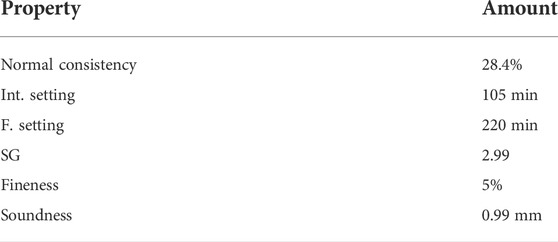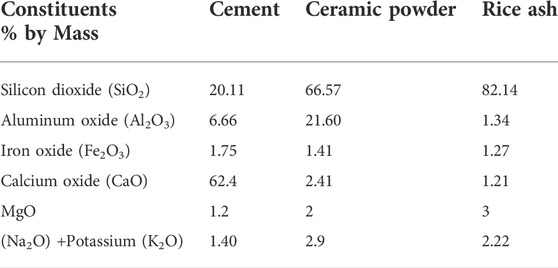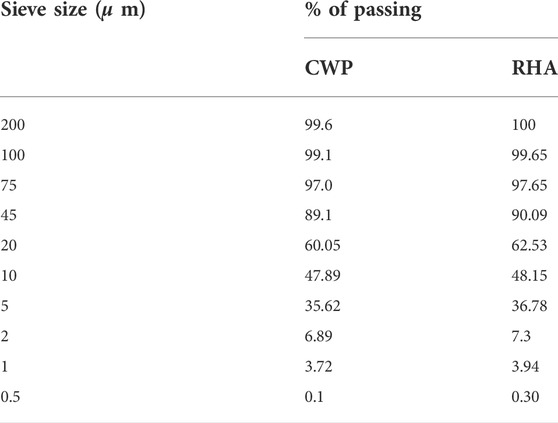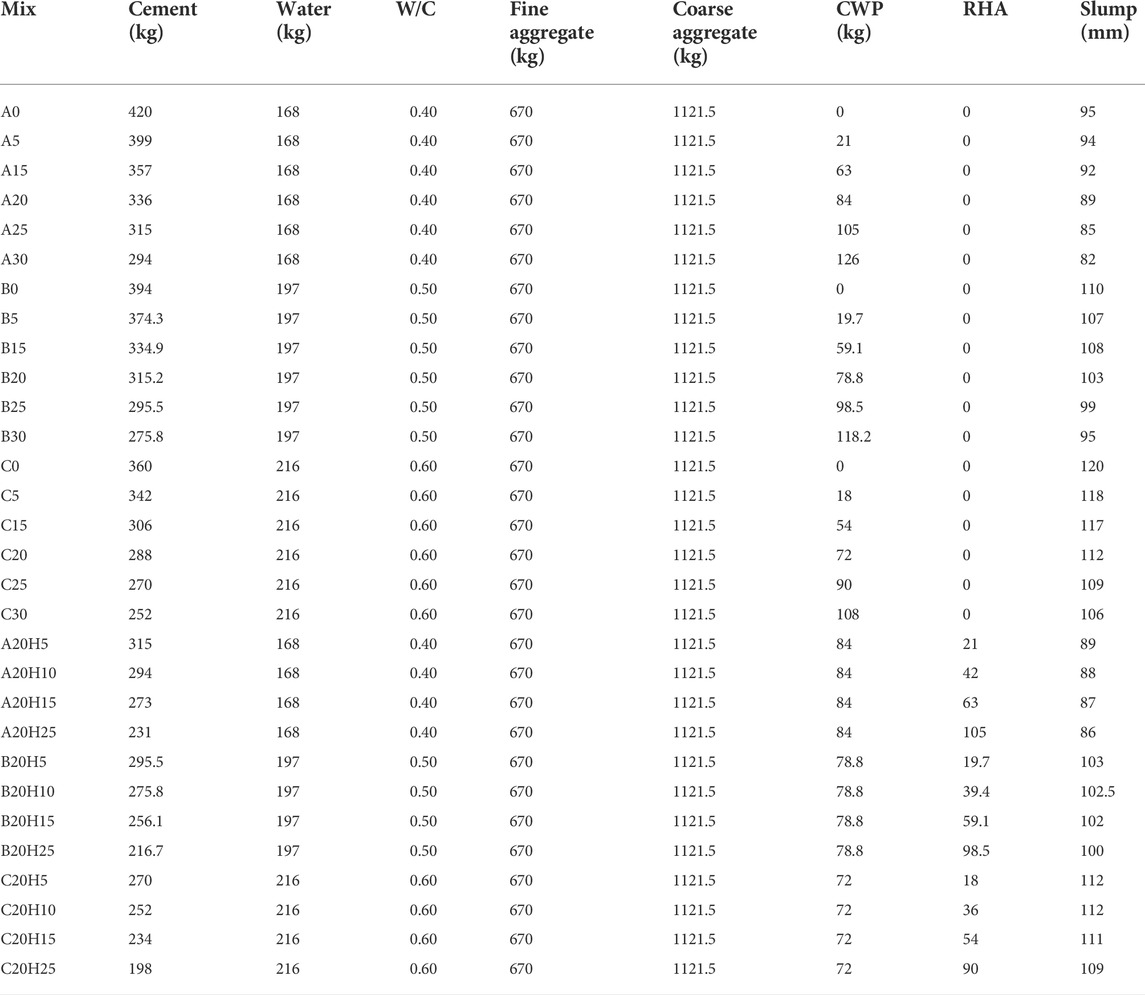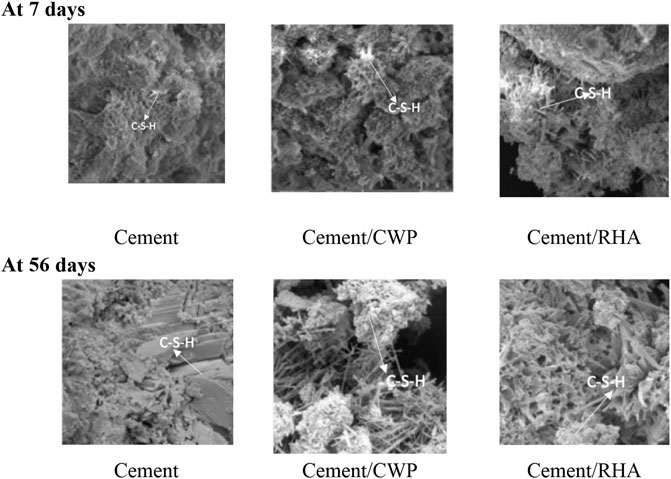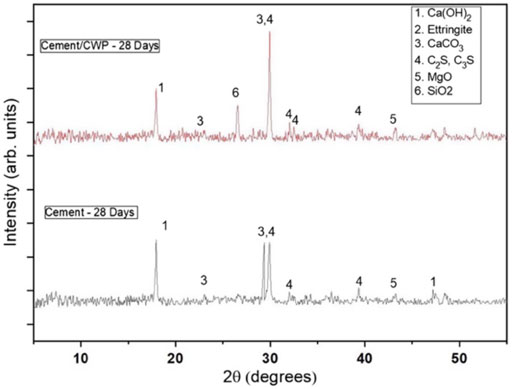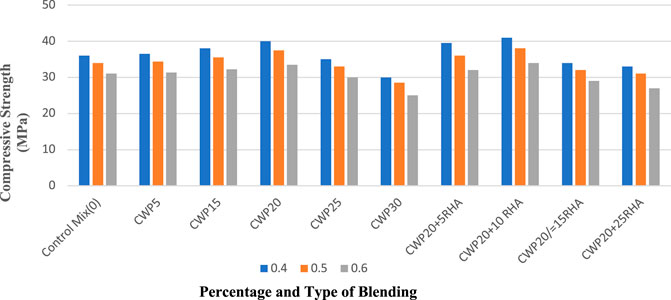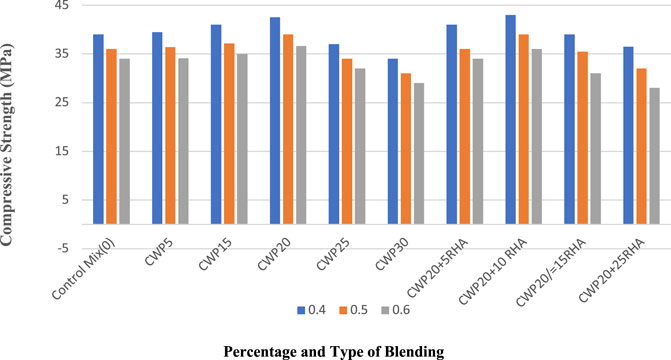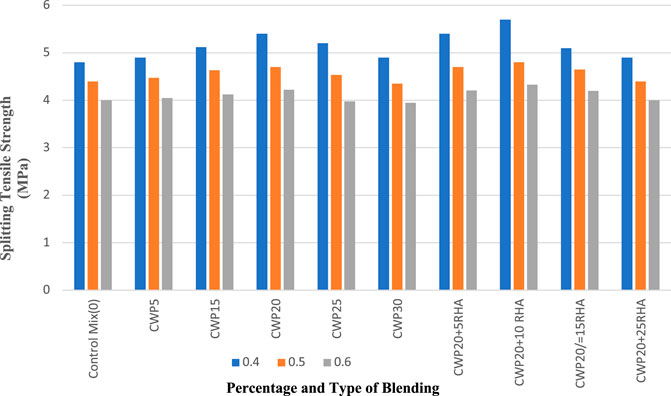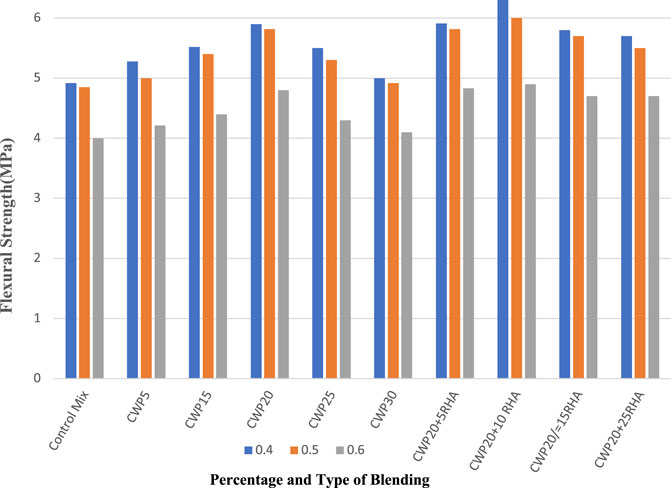- Horus University, Damietta, Egypt
The current challenge facing the construction industry is to produce sustainable concrete at the lowest feasible cost. One obstacle to that is the demand for an excessive amount of cement. The reduction of cement content can be achieved by its partial replacement with by-product materials that attain an appropriate pozzolanic index. Two by-products namely; Ceramic waste powder (CWP) and rice husk ash (RHA) are remarkably formed throughout tiles and rice production. Using these by-products as a partial substitution for cement reduces landfills, the cost of concrete, and climate change due to cement production. This paper investigates the effect of replacing 5%, 15%, 20%, 25%, and 30% of cement with CWP. Varied proportions of RHA; 5%, 10%, 15%, and 25% were added to the mix with the optimum CWP. The concrete mixture was proportioned to produce M35-grade concrete. Properties of concrete were assessed concerning workability, compressive, splitting tensile, and flexural strength. The results are compared to conventional concrete with 0% replacement. Results identified that 20% substitution of cement by CWP is the optimum percentage. It increases the compressive, splitting tensile, and flexural strength by 11%, 20%, and 12.5% respectively. Increasing the percentage up to 30% has minor effect on tensile and flexural strength but has destructive effect on compressive strength. Blending cement with CWP and RHA additionally improves the mechanical properties. The combination of 20% CWP/10% RHA propose superior strength, it increases the compressive, tensile, and flexural strength by 14%, 28%, and 19% compared to the control concrete.
Introduction
Environmental preservation and responsible usage of resources are currently the main challenges facing sustainability. Cement manufacture is precise, and are crucial factor for the maximum CO2-formation. It is reliable for approximately 5%–8% of the carbon produced worldwide (Kakaste and Hurme, 2016). If the production rate and processes are not changed, it is predicted that by 2050 the CO2 emissions will be multiplied by five times those registered in 1990 (Mohamed et al., 2012). Studies investigated the prospective usage of industrial wastes at diverse phases in the process of the production of Portland cement (Schneider et al., 2011; Singh et al., 2016; Smarzewski and Barnat-Hunek, 2016; Soltanzadeh et al., 2018). These substitutions help the ecosystem, as they lessen the influence of dumped wastes and the consumption of natural resources (Siong et al., 2016; Valdes-Vidal et al., 2018). Many by-products were assessed as a substitution for cement (Puertas et al., 2008; Sathawane et al., 2013; Park et al., 2016; Younes et al., 2018). The better the pozzolanic properties possessed by the material, the higher the opportunity to effectively replaced the cement.
Reig et al. (2013) stated that sizable quantities of ceramic waste are produced annually from demolition practices or manufacturing deficiencies. The depositing in landfills causes the occupation of massive areas of land and dust pollution. Puertas et al. (2006) stated that ceramic waste exhibited pozzolanic behavior depending on chemical composition and amorphous content. Rice husk ash (RHA) is produced plentifully through the milling of rice. About 1011 kg of RHA are formed yearly on the planet (Siddika et al., 2021). The husk shelters the grains and encloses an excessive amount of silica, commonly 85% (Abubakr et al., 2019). The high reactivity of RHA due to the presence of uncrystalline silica and a sizeable surface area (Pavia et al., 2014). The husk is considered an environmental nuisance where it is collected to a sizable extent. Thus implementation of these by-product materials in Portland cement contributes to diminishing landfill, the usage of energy, and the greenhouse accompanying cement production.
Medina et al. (2016) examined the usage of Ceramic waste powder (CWP) as a pozzolanic admixture with 10% and 20%. They concluded that the CWP has a huge consequence on the rheology and hydration of the concrete. It is usable, in low concentrations, as a supplementary-cementitious material. Reig et al. (2013) considered the performance of Portland cement combined with 15%–25% CWP. They stated that the reactivity of CWP with the Ca(OH)2 is enhanced with increased age and the strength is comparable to fly ash (Mas et al., 2016). Several studies (Puertas et al., 2008; Lavat et al., 2009; Halicka et al., 2013; El-Dieb et al., 2018; Piña-Ramírez et al., 2018) verified the advantages of CWP when used as an admixture in concrete. It is characterized by being durable and has high resistance to physical and chemical deterioration. The mechanical properties and microstructural studies of cement pastes with diverse percentages of CWP were examined (Shanmugam et al., 2020). Results showed that an enhancement in mechanical strength and reduction of Alkali-silica reaction were observed (Puertas et al., 2008; Mohit and Sharifi, 2019a; Muthukrishnan et al., 2020; Lee et al., 2021; Siddika et al., 2021). Mohit and Sharifi (2019a) verified that the CWP effectively increases the acid resistance of concrete. This is in agreement with Shanmugam et al. (2020) who stated that the permeability is enhanced by the fractional substitution of cement with CWP (Lee et al., 2021).
The characteristics of concrete in which cement is blended with RHA entitled valuable modification of concrete characteristics (Alex et al., 2016; Hu et al., 2020; Muthukrishnan et al., 2020; Ali et al., 2021; Hu et al., 2021; Siddika et al., 2021; Syahida Adnan et al., 2021). The sequential hydration of cement blended with RHA was verified (Le and Ludwig, 2020). The pozzolanic properties of RHA depend on the fineness of the amorphous silica during its processing (Fapohunda et al., 2017; Xiong et al., 2021). The fineness of RHA increases the density of concrete while decreasing the voids (Vieira et al., 2020). The pozzolanic reactions of RHA depend on the accessibility of Calcium hydrates (CH) (Nair et al., 2006; Habeeb and Mahmud, 2010; Mosaberpanah and Umar, 2020). The effectiveness was evaluated by Nair et al. (2006) who postulated that a partial substitution of cement. with RHA enhances the strength (Anwar et al., 2000; Gautam et al., 2019; Muthukrishnan et al., 2020; Thiedeitz et al., 2020; Nasiru et al., 2021; Selvaranjan et al., 2021; Wang et al., 2021).
This paper objects to lessen the greenhouse effect of cement production by assessing the optimum content of CWP and RHA to help lessen landfill, thus conserving natural non-renewable resources.
Research significance
The purpose of this paper is to reduce the consequence of the building engineering on climate change by partially replacing the cement content with waste materials. Waste materials used; CWP and RHA had been chosen based on their Pozzolanic activity index, PI (ASTM C 311) (ASTM C311/C311M-22, 2013). This also decreases the ecological impact that arises from the plentiful fabrication of wastes.
Methodology
This paper assesses the impact of substituting cement with CWP and RHA on the properties of concrete compared to the control mix. Mixes with diverse w/c; 0.40, 0.50, and 0.60 were used. CWP was used as a substitution for cement with percentage of 5%, 15%, 20%, 25%, and 30% by weight. The optimal CWP substitution is selected based on the 28-day comp. strength. The blend with the optimal replacement percentage was then dosed with diverse percentages of RHA; 5, 10, 15, and 25% by wt. of cement The slump of all mixtures was measured. The compressive, splitting tensile, and flexural strength were studied.
Materials and methods
Concrete
The control mix proportions were designed to produce M35-grade concrete. Ordinary Portland cement (OPC) was utilized. The physical properties of the cement used are demonstrated in Table 1 and the chemical composition of cement. And ceramic powder is showed in Table 2. 20 mm crushed limestone aggregate following ASTM C33 (ASTM C33, 2010) is used. The properties of aggregate are presented in Table 3. The aggregate was thoroughly cleaned to remove any deleterious contents, see Figure 1.
Ceramic waste powder
CWP used in the current research was taken from nearby Ceramics companies. 98% of the CWP passed from 90 Microns sieve. X-Ray Diffraction (XRD) and Scanning Electron Microscopy (SEM) were utilized to illustrate the microstructure of CWP. The XRD were completed as ASTM C1365 (ASTM C1365-18, 2018). The examination of the surface and the structure was indicated in accordance with ASTM C1723 (ASTM C1723-16, 2016). As presented in Table 2, CWP consists mainly of silica (SiO2) and alumina (Al2O3), approximately 88% of the total mass. CaO, MgO, and SO3 form small amounts. The mass fractions of silica, alumina, and iron fulfills the constraint of the ASTM C618.
Rice husk ash
RHA was obtained from nearby companies for the current research, 98% passed the 90
Mix proportions
Mixtures are proportioned to provide 30 MPa at 28 days. Thirty mixes are prepared, see Table 5. All mixtures are tested following ASTM C31 (American Society for Testing and Materials, 2019), the slump varied from 86 to 120 mm. Mixes are moist cured following ASTM C192 (ASTM C192, 2013).
Tests
The influence of substitution of cement with CWP with various percentages is tested to determine workability, compressive, flexural, and tensile str.
Slump test
It was done as ASTM C143 (ASTM C143-78, 2017).
Frattini test according to BS EN 196-5
The pozzolanic action of mixtures was investigated by the Frattini test (BS EN 196-5, 2011). The test determines the amount of Ca2+ and OH− in the water attached the specimens stored at 40°C for 2, 7, and 28 days. The mixtures are pozzolanic when the (CaO and OH−) in solution is lower than the solubility of CH.
Compressive strength
Six 150 mm × 150 mm × 150 mm cubes were cast from each mixture for assessing the compressive strength. The uncertainty = ±0.05 mm. The specimens were cured following ASTM 192 (ASTM C192, 2013) and were experimented at 28 and 56 days. The results are rounded to the nearest 0.1 N/mm.
Tensile strength
A total of 90 cylinder specimens with dimensions 150 mm × 300 mm were tested for detecting tensile strength. Specimens moist cured for 28. Then, three specimens for each mix were examined per ASTM C496/C496M (ASTM C 496/C 496M, 2011), and the average was noted.
Flexural strength
Flexural strength was inspected according to ASTM C78/C78M (ASTM, 2018) by three points loading. 90 beams were moist cured for 28 days. For each mix, three beams were tested till failure, and the average strength was noted.
Results and discussions
Scanning electron microscopy images
The SEM indicated that the CWP has coarser sizes in comparison to the cement, however, both CWP and cement have comparable texture and angularity. The ettringite hydrates are observed at 7-days but with various intensities. The morphology of C-S-H diverges from crystalline to reticular networks, see Figure 2. The CH crystals are extremely lower in the CWP pastes which proves the dilution of the cement due to CWP and the incidence of pozzolanic reactions that cause the conversion into C-S-H.
X-ray diffraction analysis
To evaluate the synergistic properties rising for CWP blends on pozzolanic reactions, the C/CWP pastes were assessed at 1, 28 days by an XRD analysis. They show the principal distinguishing peaks, involving ettringite (2θ 1⁄4 9.1° and 23.1°), CH (2θ 1⁄4 17.9° and 33.9°), quartz (2θ 1⁄4 26.4°), and Tricalcium silicate and Dicalcium Silicate and their semiquantitative examination shows their progression with the time. Consequently, the CH peaks recognized at early age entirely vanish at 28 days, approving their transformation to C-S-H compounds. The development of CaCO3 at 28 days is detected for all pastes due to the carbonation reaction between the CH and CO2 in the atmosphere (Ramachandran and Beaudoin, 2000). At 2θ of 8.9°, the concentration of ettringite on the first day is higher than that achieved after 28 days, verifying its conversion to a mono-sulfate. The ettringite peaks for the C/CWP are less detected competed to the cement mix, this is credited to the effect of CWP, see Figure 3. The reasonably decreased intensity of the CH peak (2θ 1⁄4 18.1°) is the indication that the CWP postulated additional C-S-H gel through consumption of CH. This is the same as Vejmelkova et al. (2012), Ali and Tavakoli (2012) postulated, causing improvement in compressive strengths.
Frattini test
At 7-days, the C/CWP displayed 20% consumption of CaO. At 7 day, the diminution of OH- and CaO displays that CWP has pozzolanic activity and the cement with excessive substitution percentages is lower than the solubility isotherm at the calcium sub saturation zone. At 28 days, the CaO consumption was nearly 59% for the mixtures with CWP. This confirms that CWP demonstrates pozzolanic activity. These results are is in agreement with previous studies (Ramachandran and Beaudoin, 2000; MehtaMonteiro); indicating that a second hydration reaction results from the CWP (Schuldyakov et al., 2016; Knop and Peled, 2018). This indicated that the exchange of calcium Hydroxide to C-S-H was promoted due to the high Si provided by CWP.
Workability
The slump was measured for all mixes, see Table 5. Although the CWP is irregular with sharp edges which are supposed to hinder their fluidity, smooth surface, and low-porosity preserve the workability of the mixes. This is in accord with that formerly described (Soltanzadeh et al., 2018). They stated that no significant change in workability was observed and reported reductions of 4.5% in mortars including CWP. On the other side, Abubakr et al. (2019) declared that the workability improved significantly signifying that CWP is considered a plasticizer.
Compressive strength
Compressive strength of specimens for different mixtures measured at 28 and 56 days are presented in Figure 4 and Figure 5 respectively. It is declared that the increase in replacement percentage caused improvement in the compressive strength to 20%. Beyond 20% of partial replacement, the compressive strength starts to decline with increasing CWP content. The maximum improvement in compressive strength was 11% attained at mixes with w/c 0.4 at 20% CWP replacement. The maximum decline in compressive was 20% compared to the reference mix attained for mix with w/c 0.6 at 30% CWP. Results at 56- days showed the same trend. It should be noted that the compressive strength for all mixtures continues to increase with age. This is attributed to the high Silica content and the pozzolanic reaction in CWP enhance the microstructure of the concrete mixture. This is in agreement with Somy Daniel and Aneeta Anna Raju (Daniel and Raju, 2018) who stated that the Compressive strength rises up to 15% substitution of cement by CWP and additional rising of CWP tends to lower the compressive strength. While, El-Dieb et al. (2018) declared that the addition of CWP in range of 20%–40% improves the compressive strength of the concrete. Reig et al. (2013) postulated that although compressive strength is considerably decreased with the incorporation of CWP at early-ages, the values improved with aging, after 1 year, the strength of mortars with 25wt% surpassed that of the control mortar. Oladimeji Benedict Olalusi and Festus Adeyemi Olutoge (Benedict Olalusi and AdeyemiOlutoge, 2017) declare that there was an increase in the strength cured in salt-water and fresh-water when CWP is added by 20%, which increases durability.
Based on the previous results the mix design with 20% CWP replacing cement is the optimum value. This is further used for blending with RHA. On testing mixtures with cement + CWP + RHA, it was detected that the compressive strength rises with the curing age. Antiohos et al. (2008) stated that the increase in RHA content slightly decreases the compressive strength at early ages, 7 days, This is attributed the reduction in compressive strength to the slow evolution of the pozzolanic action. Figures 4, 5 demonstrate the compressive strength of different mixtures blended with CWP and RHA. It can be observed that the compressive strength increased with increasing RHA percentage up to 10%. The optimum increase was 13% achieved by mix CWP20/RHA10. increasing % of RHA higher than 10% decreases the compressive strength, the maximum reduction was 13%, at 28 days attained for mixes with CWP20/RHA25 at w/c equals 0.6. The compressive strength continued to increase at age 56 days, this improvement can be accredited to the presence of silica in RHA which react with Ca. This is in accord with the results reported by Oyetola and Abdulahi (Oyetola and Abdulahi, 2006).
Splitting tensile strength
Results for mixtures with CWP indicate that as the amount of CWP rises, the splitting tensile strength increases up to 20% then the tensile strength decreases with increasing the % of substitution. The highest tensile strength was attained at 20% ceramic at different water cement ratio. The highest increase was 11, 10, and 8% for 0.4, 0.5, and 0.6 respectively. This is higher than the % suggested by Shanmugam et al. (2020) who stated that the highest splitting strength was attained at 10% replacement of cement with CWP. This is in agreement with Rewat et al (2019) (Mohit and Sharifi, 2019b), they stated that CWP can be added with 15% to improve concrete properties. However, Xiong et al. (2021) stated that the addition of CWP up to 35% decreases the porosity of concrete and hence increases the tensile strength. Splitting tensile strength of the mixes with 20% CWP and different % of RHA replacement of cement was measured at 28- days, see Figure 6. Though, the max. improvement was achieved at CWP20RHA10, nearly 12.5% at w/c equals 0.4, blending concrete with 20 CWP and 25 RHA had nearly no destructive effect on tensile strength. This shows that the blend of CWP and RHA can be effectively used for substituting cement up to 55% substitution.
Flexural strength
Inclusion of CWP rises the flexural strength at all replacement percentages. However, the optimum improvement was at 20% partial replacement for mixes with different water cement ratio. Flexural strength increased by 20% compared to the reference mixture. Though, the inclusion of CWP with 30% has minor effect on flexural strength, see Figure 7. This is in agreement with Rawat et al. (2019), they postulated that CWP increases the mechanical properties of concrete with partial replacement up to 15%. Although this is in agreement with Mehdi Mohit and Yasser Sharifi (Mohit and Sharifi, 2019b), they suggested that % of replacement should be 10%. On the other hand, Abubakr et al. (2019) indicated that the incorporation of CWP in concrete has no effect on the flexural strength, they suggested that CWP could replace cement up to 20% without destructive effect on mechanical properties. As for blended mixtures with CWP and RHA, it is observed that the addition of RHA improved the flexural strength at all %. However, the highest flexural strength was attained at CWP20RHA10 with improvement 28%, 23%, and 22.5% for mixes with 0.4, 0.5, and 0.6 respectively compared to reference mixture. This specifies that the blend of CWP/RHA could substitute cement with 45% with enhancement in flexural strength.
Conclusion
This research uses two by-product materials to be blended substituting a percentage of cement in concrete. The following points were concluded:
• The slump decreased with an increasing degree of substitution.
• The compressive strength rises with increasing replacement percentage up to 20% CWP, this % is the optimum replacement.
• Enhancement in the compressive strength by 8%–11% compared to reference mix at 28-days for mixtures with different water-cement ratio.
• RHA produced more lessening in the slump.
• Flexural strength and tensile strength at 20% CWP increase by 20, and 12.5%, additional CWP has minor effect on both strengths.
• The Compressive, flexural, and splitting tensile strength of cement for CWP20RHA10 replacement of cement attained the highest level.
• It can be concluded that cement can be substituted with CWP20RHA10 with enhancement in strength and waste consumption.
Future scope
• Blended cement with CWP/RHA should be examined for durability aspects.
• Characteristics as permeable pores, thermal properties, and rheology should be evaluated.
• The results indicated that the utilization of CWP/RHA in the production of concrete is beneficial in terms of attaining low-cost and durable concrete and solving ecological troubles.
Data availability statement
The original contributions presented in the study are included in the article/Supplementary Material, further inquiries can be directed to the corresponding author.
Author contributions
The author confirms being the sole contributor of this work and has approved it for publication.
Conflict of interest
The authors declare that the research was conducted in the absence of any commercial or financial relationships that could be construed as a potential conflict of interest.
Publisher’s note
All claims expressed in this article are solely those of the authors and do not necessarily represent those of their affiliated organizations, or those of the publisher, the editors and the reviewers. Any product that may be evaluated in this article, or claim that may be made by its manufacturer, is not guaranteed or endorsed by the publisher.
References
Abubakr, M., Khitab, A., Anwar, W., Tayyab, S., and Shamsher, S. (2019). “Evaluation of ordinary concrete having ceramic waste powder as partial replacement of cement,” in Proceedings of the International Conference on Sustainable Development in Civil Engineering MUET, Pakistan, December 2019.
Alex, J., Dhanalakshmi, J., and Ambedkar, B. (2016). Experimental investigation on rice husk ash as cement replacement on concrete production. Constr. Build. Mater. 127, 353–362. doi:10.1016/j.conbuildmat.2016.09.150
Ali, H, and Tavakoli, D. (2012). Performance of ceramic tile powder as a pozzolanic material in concrete. Asian J. Civ. Eng. 13, 369–382.
Ali, T., Saand, A., Bangwar, D. K., Buller, A. S., and Ahmed, Z. (2021). Mechanical and durability properties of aerated concrete incorporating rice husk ash (RHA) as partial replacement of cement. Crystals 11, 604. doi:10.3390/cryst11060604
American Society for Testing and Materials (2019). ASTM C31-19_Standard practice for making and curing concrete test specimens in the field. West Conshohocken, PA, USA: ASTM International. doi:10.1520/C0031
Antiohos, S., Maganari, K., and Tsimas, S. (2008). Evaluation of blends of high and low calcium fly ashes for use as supplementary cementing materials. Cem. Concr. Comp. 22 (5), 932–936. doi:10.1016/j.cemconcomp.2004.05.001
Anwar, M., Miyagawa, T., and Gaweesh, M. (2000). “Using rice husk ash as a cement replacement material in concrete,”in Waste Materials in Construction Wascon. Editors G. R. Woolley, J. J. J. M. Goumans, and P. J. Wainwright (Elsevier), 1, 671–684. Waste Manag. Ser. doi:10.1016/S0713-2743(00)80077-X
ASTM C 496/C 496M (2011). Standard test method for splitting tensile strength of cylindrical concrete specimens. West Conshohocken, PA, USA: ASTM International. doi:10.1520/C0496-96
ASTM C1365-18 (2018). Standard test method for determination of the proportion of phases in Portland cement and portland-cement clinker using X-ray powder diffraction analysis. West Conshohocken, PA, USA: ASTM International. doi:10.1520/C1365-18
ASTM C143-78 (2017). Standard test method for slump of Portland cement concrete. West Conshohocken, PA, USA: ASTM International.
ASTM C1723-16 (2016). Standard guide for examination of hardened concrete using scanning Electron microscopy. West Conshohocken, PA, USA: ASTM International. doi:10.1520/C1723-16
ASTM C311/C311M-22 (2013). Standard test methods for sampling and testing fly ash or natural pozzolans for use in portland-cement concrete. West Conshohocken, PA, USA: ASTM International. doi:10.1520/C0311_C0311M-22
ASTM C33 (2010). Standard specification for concrete aggregates. West Conshohocken, PA, USA: ASTM International. doi:10.1520/C0033C0033M-18
ASTM C192 (2013). Standard practice for making and curing concrete test specimens in the laboratory. West Conshohocken, PA, USA: ASTM International. doi:10.1520/C0192_C0192M-15
ASTM (2018). Standard test method for flexural strength of concrete (using simple beam with third-point loading). West Conshohocken, PA, USA: ASTM C78, ASTM International. doi:10.1520/C0078_C0078M-22
Benedict Olalusi, O., and Adeyemi Olutoge, F. (2017). Effect of salt water on the compressive strength of ceramic powder concrete. Am. J. Eng. Res. 6, 158–163.
Daniel, S., and Raju, A. A. (2018). A study of properties of concrete making partial replacement of cement by ceramic waste powder. Mater. Sci.
El-Dieb, A. S., Taha, M. R., and Abu-Eishah, S. I. (2018). The use of ceramic waste powder (CWP) in making eco-friendly concretes. Ceram. Mater. doi:10.5772/intechopen.81842
Fapohunda, C., Akinbile, B., and Shittu, A. (2017). Structure and properties of mortar and concrete with rice husk ash as partial replacement of ordinary Portland cement – a review. Int. J. Sustain. Built Environ. 6, 675–692. doi:10.1016/j.ijsbe.2017.07.004
Gautam, A., Batra, R., and Singh, N. (2019). A study on use of rice husk ash in concrete. Eng. Herit. J. 3, 1–4. doi:10.26480/gwk.01.2019.01.04
Habeeb, G. A., and Mahmud, H. B. (2010). Study on properties of rice husk ash and its use as cement replacement material. Mat. Res. 13, 185–190. doi:10.1590/s1516-14392010000200011
Halicka, A., Ogrodnik, P., and Zegardlo, B. (2013). Using ceramic sanitary ware waste as concrete aggregate. Constr. Build. Mat. 4848, 295–305. doi:10.1016/j.conbuildmat.2013.06.063
Hu, L., He, Z., Shao, Y., Cai, X., and Zhang, S. (2021). Microstructure and properties of sustainable cement-based materials using combustion treated rice husk ash. Constr. Build. Mater. 294, 123482. doi:10.1016/j.conbuildmat.2021.123482
Hu, L., He, Z., and Zhang, S. (2020). Sustainable use of rice husk ash in cement-based materials: Environmental evaluation and performance improvement. J. Clean. Prod. 264, 121744. doi:10.1016/j.jclepro.2020.121744
Kakaste, R., and Hurme, M. (2016). Cement industry greenhouse gas emissions – management options and abatement cost. J. Clean. Prod. 112, 4041–4052. doi:10.1016/J.JCLEPRO.2015.07.055
Knop, Y, and Peled, A (2018). Sustainable blended cements—influences of packing density on cement paste chemical efficiency. Materials 4, 625. doi:10.3390/ma11040625
Lavat, A. E., Trezza, M. A., and Poggi, M. (2009). Characterization of ceramic roof tile wastes as pozzolanic admixture. Waste Manag. 29, 1666–1674. doi:10.1016/j.wasman.2008.10.019
Le, H. T., and Ludwig, H-M. (2020). Alkali silica reactivity of rice husk ash in cement paste. Constr. Build. Mater. 243, 118145. doi:10.1016/j.conbuildmat.2020.118145
Lee, Y. L., Lim, S. K., Lim, M. H., Lee, F. W., and Yew, M. K. (2021). Effect of ceramic dust as partial replacement of cement on lightweight foamed concrete. Int. J. Integr. Eng. 13, 304–312. doi:10.30880/ijie.2021.13.04.029
Mas, M. A., Monzó, J., Payá, J., Reig, L., and Borrachero, M. V. (2016). Ceramic tiles waste as replacement Material in Portland cement. Adv. Cem. Res. 28. doi:10.1680/jadcr.15.00021
Medina, C., Sánchez de Rojas, M. I., Thomas, C., Polanco, J. A., and Frías, M. (2016). Durability of recycled concrete made with recycled ceramic sanitary ware aggregate. Inter-indicator relationships. Constr. Build. Mater. 105, 480–486. doi:10.1016/j.conbuildmat.2015.12.176
Mehta, P. K., and Monteiro, P. J. M. (2013). Concrete: Microstructure, properties, and materials. 4th. New York: McGraw-Hill Education.
Mohamed, I., Carrigan, C., and Mckenna, S. (2012). Trends and developments in green cement and concrete technology. Int. J. Sustain. Built Environ. 1 (2), 194–216. doi:10.1016/j.ijsbe.2013.05.001
Mohit, M., and Sharifi, Y. (2019). Ceramic waste powder as alternative mortar-based cementitious materials. ACI Mat. J. 116. doi:10.14359/51716819
Mohit, M., and Sharifi, Y. (2019). Thermal and microstructure properties of cement mortar containing ceramic waste powder as alternative cementitious materials. Constr. Build. Mater 223, 643–656. doi:10.1016/j.conbuildmat.2019.07.029
Mosaberpanah, M. A., and Umar, S. A. (2020). Utilizing rice husk ash as supplement to cementitious materials on performance of ultra high-performance concrete: – a review. Mater. Today Sustain. 7, 100030. doi:10.1016/j.mtsust.2019.100030
Muthukrishnan, S., Kua, H. W., Yu, L. N., and Chung, J. K. H. (2020). Fresh properties of cementitious materials containing rice husk ash for construction 3D printing. J. Mat. Civ. Eng. 32, 04020195. doi:10.1061/(asce)mt.1943-5533.0003230
Nair, D. G., Jagadish, K. S., and Fraaij, A. (2006). Reactive pozzolanas from rice husk ash: An alternative to cement for rural housing. Cem. Concr. Res. 36, 1062–1071. doi:10.1016/j.cemconres.2006.03.012
Nasiru, S., Jiang, L., Yu, L., Chu, H., Huang, Y., Pei, C., et al. (2021). Properties of cement mortar containing recycled glass and rice husk ash. Constr. Build. Mater. 299, 123900. doi:10.1016/j.conbuildmat.2021.123900
Oyetola, B. E., and Abdulahi, M. (2006). The use of rice husk ash in low-cost concrete block production. Leonardo Electron. J. Pract. Technol. 8, 58–70.
Park, K.-B., Kwon, S.-J., and Wang, X.-Y. (2016). Analysis of the effects of rice husk ash on the hydration of cementitious materials. Constr. Build. Mater. 105, 196–205. doi:10.1016/j.conbuildmat.2015.12.086
Pavia, S., Walker, R., Veale, P., and Wood, A. (2014). Impact of the properties and reactivity of rice husk ash on lime mortar properties. J. Mat. Civ. Eng. 26 (9). doi:10.1061/(ASCE)MT.1943-5533.0000967
Piña-Ramírez, C., Atanes-Sánchez, E., del Río-Merino, M., Viñas-Arrebola, C., and Vidales-Barriguete, A. (2018). Feasibility of the use of mineral wool fibres recovered from CDW for the reinforcement of conglomerates by study of their porosity. Constr. Build. Mater. 191, 460–468. doi:10.1016/j.conbuildmat.2018.10.026
Puertas, F., Barba, A., Gazulla, M. F., Gómez, M. P., Palacios, M., and Martı´nez-Ramı´ rez, S. (2006). Ceramics wastes as raw material in Portland cement clinker fabrication: Characterization and alkaline activation. Mater. Constr. 56 (281), 73–84.
Puertas, F., García-Díaz, I., Barba, A., Gazulla, M. F., Palacios, M., Gómez, M. P., et al. (2008). Ceramic wastes as alternative raw materials for Portland cement clinker production. Cem. Concr. Compos. 30 (9), 798–805. doi:10.1016/j.cemconcomp.2008.06.003
Ramachandran, V. s., and Beaudoin, J. J. (2000). Handbook of analytical techniques in concrete science and technology. 1st edition. Amsterdam, Netherlands: Elsevier.
Rawat, R., Singh, A., and Bohra, M. (2019). Investigation of ceramic waste as supplementary cementitious material in concrete. Int. J. Appl. Eng. Res. ISSN 14 (9), 973–4562.
Reig, L., Mitsuuchi Tashima, M., Borrachero, M. V., Monzo, J., Cheeseman, C. R., and Paya, J. (2013). Properties and microstructure of alkali-activated red clay brick waste. Constr. Build. Mater. 43, 98–106. doi:10.1016/j.conbuildmat.2013.01.031
Sathawane, S. H., Vairagade, V. S., and Kene, K. S. (2013). Combine effect of rice husk ash and fly ash on concrete by 30% cement replacement. Procedia Eng. 51, 35–44. doi:10.1016/j.proeng.2013.01.009
Schneider, M., Romer, M., Tschudin, M., and Bolio, H. (2011). Sustainable cement production-present and future. Cem. Concr. Res. 41 (7), 642–650. doi:10.1016/j.cemconres.2011.03.019
Schuldyakov, K. V., Kramar, L. Ya., and Trofimov, B. Ya. (2016). The properties of Slag Cement and its influence on the structure of the hardened Cement Paste. Procedia Eng. 150, 1433–1439. doi:10.1016/j.proeng.2016.07.202
Selvaranjan, K., Navaratnam, S., Gamage, J. C. P. H., Thamboo, J., Siddique, R., Zhang, J., et al. (2021). Thermal and environmental impact analysis of rice husk ash-based mortar as insulating wall plaster. Constr. Build. Mater. 283, 122744. doi:10.1016/j.conbuildmat.2021.122744
Shanmugam, D., Chinnasamy, K., Natrajan, K., Kumar, S., Elangovan, S., and Raj, J. P. (2020). “Eco-Efficient” concrete incorporating ceramic waste powder and red brick dust as an effective replacement for ordinary Portland cement and fine aggregate. IOP Conf. Ser. Mat. Sci. Eng. 955, 012041. doi:10.1088/1757-899X/955/1/012041
Siddika, A., Mamun, M. A. A., Alyousef, R., and Mohammadhosseini, H. (2021). State-of-the-art-review on rice husk ash: A supplementary cementitious material in concrete. J. King Saud Univ. 33, 294–307. doi:10.1016/j.jksues.2020.10.006
Singh, G., Kumar, S., Singh, M. K., and Mohapatra, S. K. (2016). Environmental impact assessment of ash disposal system of a thermal power plant. Int. J. Hydrogen Energy 41 (35), 15887–15891. doi:10.1016/j.ijhydene.2016.03.171
Siong, H. C., Warid, M. N. M., Mirza, J., Rafieizonooz, M., Salim, M. R., et al. (2016). On blended cement and geopolymer concretes containing palm oil fuel ash. Mater. Des. 89, 385–398. doi:10.1016/j.matdes.2015.09.140
Smarzewski, P., and Barnat-Hunek, D. (2016). Mechanical and durability related properties of high-performance concrete made with coal cinder and waste foundry sand. Constr. Build. Mater. 121, 9–17. doi:10.1016/j.conbuildmat.2016.05.148
Soltanzadeh, F., Emam-Jomeh, M., Edalat-Behbahani, A., and SoltanZadeh, Z. (2018). Development and characterization of blended cements containing seashell powder. Constr. Build. Mater. 161, 292–304. doi:10.1016/j.conbuildmat.2017.11.111
Syahida Adnan, Z., Ariffin, N. F., Syed Mohsin, S. M., and Abdul Shukor Lim, N. H. (2021). Review paper: Performance of rice husk ash as a material for partial cement replacement in concrete. Mater. Today Proc. 48, 842–848. doi:10.1016/j.matpr.2021.02.400
Thiedeitz, M., Schmidt, W., Härder, M., and Kränkel, T. (2020). Performance of rice husk ash as supplementary cementitious material after production in the field and in the lab. Materials 13, 4319. doi:10.3390/ma13194319
Valdes-Vidal, G., Calabi-Floody, A., and Sanchez-Alonso, E. (2018). Performance evaluation of warm mix asphalt involving natural zeolite and reclaimed asphalt pavement (RAP) for sustainable pavement construction. Constr. Build. Mater. 174, 576–585. doi:10.1016/j.conbuildmat.2018.04.149
Vejmelkova, E, Dana, K, Cachova, M, Keppert, M, and Cerny, R (2012). Effect of hydrophobization on the properties of lime–metakaolin plasters. Constr. Build. Mater. 37, 556–561. doi:10.1016/j.conbuildmat.2012.07.097
Vieira, A. P., Toledo Filho, R. D., Tavares, L. M., and Cordeiro, G. C. (2020). Effect of particle size, porous structure and content of rice husk ash on the hydration process and compressive strength evolution of Concrete. Constr. Build. Mater. 236, 117553. doi:10.1016/j.conbuildmat.2019.117553
Wang, J., Xiao, J., Zhang, Z., Han, K., Hu, X., and Jiang, F. (2021). Action mechanism of rice husk ash and the effect on main performances of cement-based materials: A review. Constr. Build. Mater. 288, 123068. doi:10.1016/j.conbuildmat.2021.123068
Xiong, Y., Xu, G., Wu, D., Fang, S., and Tang, Y. (2021). Investigation of using the ceramic polishing brick powder in engineered cementitious composites. J. Build. Eng. 43, 102489. doi:10.1016/j.jobe.2021.102489
Keywords: tile waste, ceramic powder, rice ash, climate change, cement replacement, sustainable concrete, by-products, mechanical properties
Citation: El-Nadoury WW (2022) Eco-friendly concrete using by-products as partial replacement of cement. Front. Mater. 9:1043037. doi: 10.3389/fmats.2022.1043037
Received: 13 September 2022; Accepted: 06 October 2022;
Published: 20 October 2022.
Edited by:
Patricia Krawczak, Institut Mines-Télécom, FranceReviewed by:
Nur Farhayu Ariffin, Universiti Malaysia Pahang, MalaysiaMing Kun Yew, Tunku Abdul Rahman University, Malaysia
Copyright © 2022 El-Nadoury. This is an open-access article distributed under the terms of the Creative Commons Attribution License (CC BY). The use, distribution or reproduction in other forums is permitted, provided the original author(s) and the copyright owner(s) are credited and that the original publication in this journal is cited, in accordance with accepted academic practice. No use, distribution or reproduction is permitted which does not comply with these terms.
*Correspondence: Wegdan W. El-Nadoury, d2VnZGFuZWxuYWRvdXJ5QGdtYWlsLmNvbQ==
 Wegdan W. El-Nadoury
Wegdan W. El-Nadoury